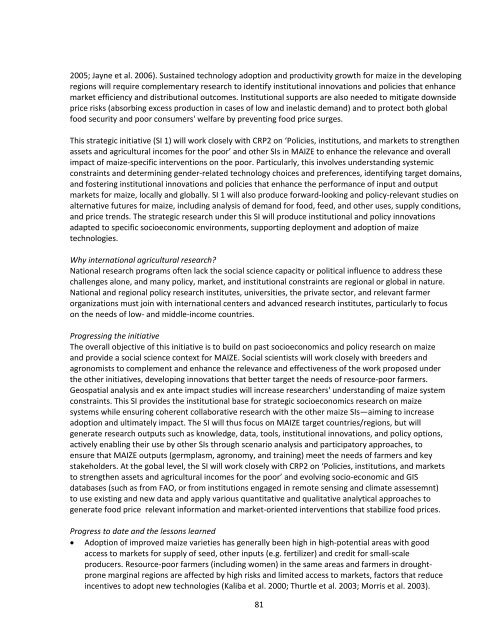Download - Maize
Download - Maize
Download - Maize
You also want an ePaper? Increase the reach of your titles
YUMPU automatically turns print PDFs into web optimized ePapers that Google loves.
2005; Jayne et al. 2006). Sustained technology adoption and productivity growth for maize in the developing<br />
regions will require complementary research to identify institutional innovations and policies that enhance<br />
market efficiency and distributional outcomes. Institutional supports are also needed to mitigate downside<br />
price risks (absorbing excess production in cases of low and inelastic demand) and to protect both global<br />
food security and poor consumers' welfare by preventing food price surges.<br />
This strategic initiative (SI 1) will work closely with CRP2 on ‘Policies, institutions, and markets to strengthen<br />
assets and agricultural incomes for the poor’ and other SIs in MAIZE to enhance the relevance and overall<br />
impact of maize‐specific interventions on the poor. Particularly, this involves understanding systemic<br />
constraints and determining gender‐related technology choices and preferences, identifying target domains,<br />
and fostering institutional innovations and policies that enhance the performance of input and output<br />
markets for maize, locally and globally. SI 1 will also produce forward‐looking and policy‐relevant studies on<br />
alternative futures for maize, including analysis of demand for food, feed, and other uses, supply conditions,<br />
and price trends. The strategic research under this SI will produce institutional and policy innovations<br />
adapted to specific socioeconomic environments, supporting deployment and adoption of maize<br />
technologies.<br />
Why international agricultural research?<br />
National research programs often lack the social science capacity or political influence to address these<br />
challenges alone, and many policy, market, and institutional constraints are regional or global in nature.<br />
National and regional policy research institutes, universities, the private sector, and relevant farmer<br />
organizations must join with international centers and advanced research institutes, particularly to focus<br />
on the needs of low‐ and middle‐income countries.<br />
Progressing the initiative<br />
The overall objective of this initiative is to build on past socioeconomics and policy research on maize<br />
and provide a social science context for MAIZE. Social scientists will work closely with breeders and<br />
agronomists to complement and enhance the relevance and effectiveness of the work proposed under<br />
the other initiatives, developing innovations that better target the needs of resource‐poor farmers.<br />
Geospatial analysis and ex ante impact studies will increase researchers' understanding of maize system<br />
constraints. This SI provides the institutional base for strategic socioeconomics research on maize<br />
systems while ensuring coherent collaborative research with the other maize SIs—aiming to increase<br />
adoption and ultimately impact. The SI will thus focus on MAIZE target countries/regions, but will<br />
generate research outputs such as knowledge, data, tools, institutional innovations, and policy options,<br />
actively enabling their use by other SIs through scenario analysis and participatory approaches, to<br />
ensure that MAIZE outputs (germplasm, agronomy, and training) meet the needs of farmers and key<br />
stakeholders. At the gobal level, the SI will work closely with CRP2 on ‘Policies, institutions, and markets<br />
to strengthen assets and agricultural incomes for the poor’ and evolving socio‐economic and GIS<br />
databases (such as from FAO, or from institutions engaged in remote sensing and climate assessemnt)<br />
to use existing and new data and apply various quantitative and qualitative analytical approaches to<br />
generate food price relevant information and market‐oriented interventions that stabilize food prices.<br />
Progress to date and the lessons learned<br />
Adoption of improved maize varieties has generally been high in high‐potential areas with good<br />
access to markets for supply of seed, other inputs (e.g. fertilizer) and credit for small‐scale<br />
producers. Resource‐poor farmers (including women) in the same areas and farmers in droughtprone<br />
marginal regions are affected by high risks and limited access to markets, factors that reduce<br />
incentives to adopt new technologies (Kaliba et al. 2000; Thurtle et al. 2003; Morris et al. 2003).<br />
81

















